|
|
Post by UKarchaeology on Aug 8, 2015 12:21:01 GMT
Post any pictures of Roman treasures/artifacts found in the UK here! (^ Roman cremation urn in green glass. Found in a Roman cemetery in Barrow upon Soar in 1867 along with other outstanding grave goods including two other large intact urns. Each contained human cremation remains and was sealed with lead. Much of the cemetery was undisturbed www.barrowuponsoarheritage.org.uk/thearchaeologyofbarrowuponsoar.html )
|
|
|
|
Post by UKarchaeology on Aug 10, 2015 19:06:59 GMT
|
|
|
|
Post by UKarchaeology on Aug 10, 2015 19:17:04 GMT
|
|
|
|
Post by UKarchaeology on Aug 10, 2015 19:22:59 GMT
|
|
|
|
Post by UKarchaeology on Aug 10, 2015 19:39:33 GMT
|
|
|
|
Post by UKarchaeology on Aug 10, 2015 19:50:44 GMT
Roman Glass fragment (probably from a glass drinking cup); 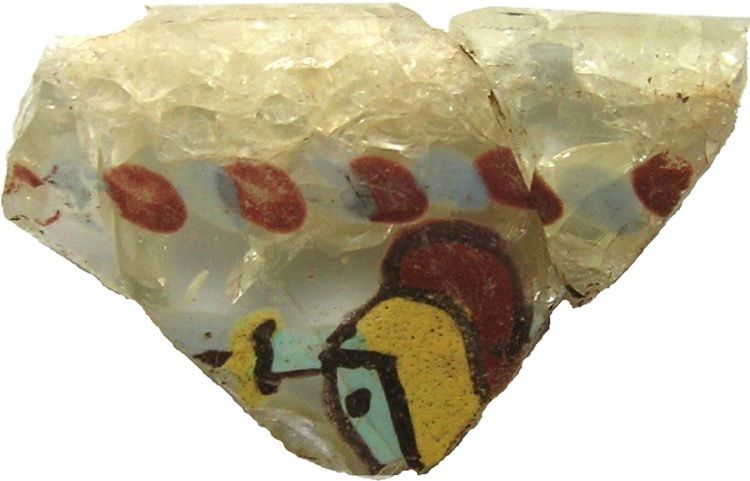 Two rim fragments of a glass vessel (one pictured here) dating from the Roman period, that is c. AD150-225 (Mid-second to early third century AD). The fragments make up a small triangular sherd of glass from the rim of the vessel which was probably a cylindrical cup with fire-rounded rim and double-base ring. Glass cups of this type were normally made from colourless or greenish-colourless glass, occasionally with a blueish-green tinge. On the inside this glass fragment is plain, but the outside has been decorated with a painted ornament composed of a dotted border (alternating blue and red dots) with the remains of a head and sword below. The head is helmeted and behind it is what appears to be a sword, held horizontally over the shoulder as if to carry out a blow. The helmet was painted in yellow and red, the face (or presumably face mask) is light blue, with a black outline and black dot for an eye. The sword hand or hilt is yellow while the blade is light blue with a black outline on the underside. The figure was probably a gladiator (pers comm Tim Padley) and may have come from the same workshop which the almost complete painted glass vessel from Vindolanda came from. The glass vessel from Vindolanda has been attributed to workshops in Germany. There are also three rim fragments decorated with painted dots from Birdoswald, but more colours were used here (white, pale green, deep pink, pale yellow and pale blue) (Willmott 1997, 343). However, the fragment from the Maryport area is small and it is very likely that more colours were used on this, too. Wilmott writes further, on the fragments from Birdoswald: "No further decoration is visible, but there can be no doubt that this vessel belongs to a group of cups decorated with animal fights and chases, gladiatorial contests, fishes, etc, found in the North West provinces and outside the northern frontier. Where the rim is preserved, these vessels are invariably decorated with one or more rows of painted dots below the rim, arranged either as single dots side by side, or in groups associated with horizontal streaks..." Cups of this kind come from Roman sites in Denmark and Germany, but also from Britain where they have been found mainly from sites close to the northern frontier. Two rim fragments of a glass vessel (one pictured here) dating from the Roman period, that is c. AD150-225 (Mid-second to early third century AD). The fragments make up a small triangular sherd of glass from the rim of the vessel which was probably a cylindrical cup with fire-rounded rim and double-base ring. Glass cups of this type were normally made from colourless or greenish-colourless glass, occasionally with a blueish-green tinge. On the inside this glass fragment is plain, but the outside has been decorated with a painted ornament composed of a dotted border (alternating blue and red dots) with the remains of a head and sword below. The head is helmeted and behind it is what appears to be a sword, held horizontally over the shoulder as if to carry out a blow. The helmet was painted in yellow and red, the face (or presumably face mask) is light blue, with a black outline and black dot for an eye. The sword hand or hilt is yellow while the blade is light blue with a black outline on the underside. The figure was probably a gladiator (pers comm Tim Padley) and may have come from the same workshop which the almost complete painted glass vessel from Vindolanda came from. The glass vessel from Vindolanda has been attributed to workshops in Germany. There are also three rim fragments decorated with painted dots from Birdoswald, but more colours were used here (white, pale green, deep pink, pale yellow and pale blue) (Willmott 1997, 343). However, the fragment from the Maryport area is small and it is very likely that more colours were used on this, too. Wilmott writes further, on the fragments from Birdoswald: "No further decoration is visible, but there can be no doubt that this vessel belongs to a group of cups decorated with animal fights and chases, gladiatorial contests, fishes, etc, found in the North West provinces and outside the northern frontier. Where the rim is preserved, these vessels are invariably decorated with one or more rows of painted dots below the rim, arranged either as single dots side by side, or in groups associated with horizontal streaks..." Cups of this kind come from Roman sites in Denmark and Germany, but also from Britain where they have been found mainly from sites close to the northern frontier.source: finds.org.uk/database/artefacts/record/id/598281 |
|
|
|
Post by UKarchaeology on Aug 10, 2015 20:07:02 GMT
Roman Intaglio; 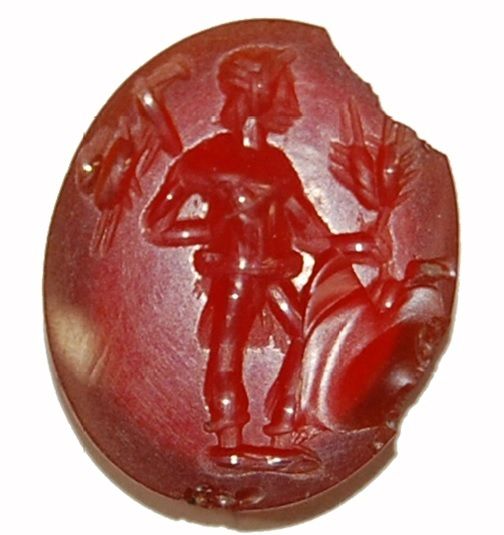 Carnelian intaglio, length 15mm, width 12mm, thickness 3mm, weight 0.74g. This is oval in plan. Engraved on the face is a male figure facing right, in his left hand are two ears of corn. Over his right shoulder is a lagobolon with a hare suspended on the end. This is Bonus Eventus the personification of a good outcome. Carnelian intaglio, length 15mm, width 12mm, thickness 3mm, weight 0.74g. This is oval in plan. Engraved on the face is a male figure facing right, in his left hand are two ears of corn. Over his right shoulder is a lagobolon with a hare suspended on the end. This is Bonus Eventus the personification of a good outcome.
The reverse is plain and the sides are bevelled.finds.org.uk/database/artefacts/record/id/469397 |
|
|
|
Post by UKarchaeology on Aug 10, 2015 20:27:40 GMT
|
|
|
|
Post by UKarchaeology on Aug 10, 2015 20:44:03 GMT
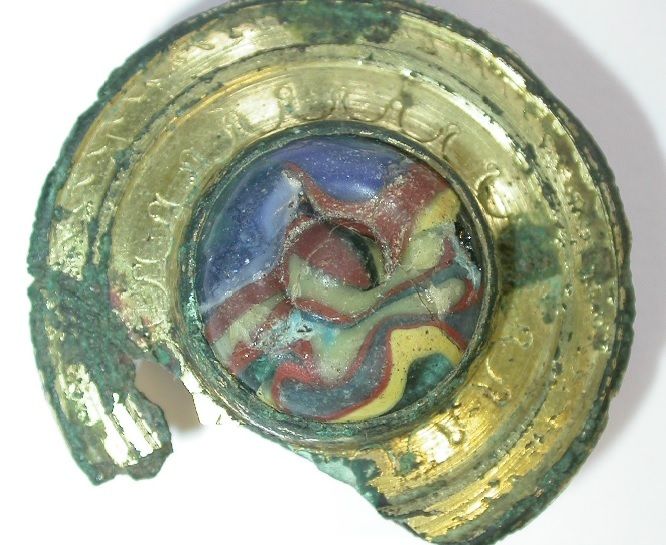 Incomplete Roman gilded copper alloy disc brooch with central multi-coloured glass setting, 3rd or 4th century. Roughly 1/6th of the disc is broken off. The disc is divided into three zones by concentric ribs. The inner collar secures a blue, red and yellow glass setting which is in the form of an outer ring with a central recessed rounded nipple; the colours in the glass are randomly mixed. The middle zone is decorated with fine punched half-circles alternating with punched annulets at their open ends, creating a wave pattern. The outer ring has fine punched decoration of short, slightly undulating diagonal lines (not quite SSS). On the reverse is a single pierced lug to hold the, now missing, pin; the catchplate is missing - it would have been on the part of the disc that is broken off. The obverse is heavily gilded & there are traces of tinning/silvering on the reverse, including the lug. Diameter 34.43mm, thickness overall including glass & lug 14.4mm, thickness across centre (not including lug) 8.63mm, thickness at rim 1.84mm, weight 12.72g. Incomplete Roman gilded copper alloy disc brooch with central multi-coloured glass setting, 3rd or 4th century. Roughly 1/6th of the disc is broken off. The disc is divided into three zones by concentric ribs. The inner collar secures a blue, red and yellow glass setting which is in the form of an outer ring with a central recessed rounded nipple; the colours in the glass are randomly mixed. The middle zone is decorated with fine punched half-circles alternating with punched annulets at their open ends, creating a wave pattern. The outer ring has fine punched decoration of short, slightly undulating diagonal lines (not quite SSS). On the reverse is a single pierced lug to hold the, now missing, pin; the catchplate is missing - it would have been on the part of the disc that is broken off. The obverse is heavily gilded & there are traces of tinning/silvering on the reverse, including the lug. Diameter 34.43mm, thickness overall including glass & lug 14.4mm, thickness across centre (not including lug) 8.63mm, thickness at rim 1.84mm, weight 12.72g.
A similar complete brooch is published in Murawski, 2003 "Benet's Artefacts of England & the United Kingdom" p.127 ref RO7-0306 - on this example the colours in the glass are in a spiral, rather than random. Gilded disc brooches with central glass settings are discussed in Bayley & Butcher "Roman Brooches in Britain" (2004, Society of Antiquaries, London) p.178-9, dated to the 3rd/4th century, and thought to be of British manufacture as relatively few are known from the continent. They note that most circular brooches of this type are of bronze, while oval examples are usually brass.finds.org.uk/database/artefacts/record/id/246103 |
|
|
|
Post by UKarchaeology on Aug 10, 2015 20:47:44 GMT
|
|
|
|
Post by UKarchaeology on Aug 10, 2015 20:57:37 GMT
Roman bird broach; 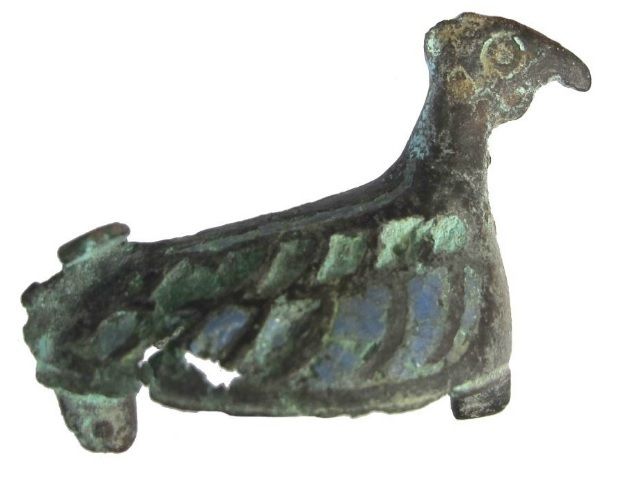 A large enamelled copper-alloy brooch in the form of a sitting duck or cocekrel. The brooch dates to the early Roman period. The body is convex in cross-section and pointed oval in plan. The head is narrow with a curved beak and large circular eyes. On the top of the head is a narrow crest. There are recessed bands around the eyes that were probably once enamelled. The body is decorated with two recessed lines down the back that contain blue enamel. Both wings contain two rows of comma-shaped cells containing blue enamel. A catchplate is located beneath the neck and two lugs are located beneath the tail. The pin is missing.finds.org.uk/database/artefacts/record/id/482823 A large enamelled copper-alloy brooch in the form of a sitting duck or cocekrel. The brooch dates to the early Roman period. The body is convex in cross-section and pointed oval in plan. The head is narrow with a curved beak and large circular eyes. On the top of the head is a narrow crest. There are recessed bands around the eyes that were probably once enamelled. The body is decorated with two recessed lines down the back that contain blue enamel. Both wings contain two rows of comma-shaped cells containing blue enamel. A catchplate is located beneath the neck and two lugs are located beneath the tail. The pin is missing.finds.org.uk/database/artefacts/record/id/482823(Cockerels/Roosters were a symbol of the Roman god Mercury while ducks were also a symbol in the Celtic world) |
|
|
|
Post by UKarchaeology on Aug 10, 2015 21:23:47 GMT
|
|
|
|
Post by UKarchaeology on Aug 10, 2015 21:28:15 GMT
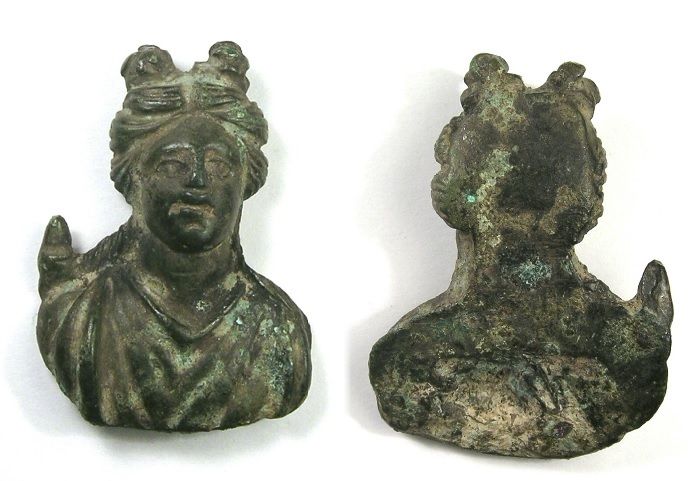 Cast cu-alloy furniture mount or fitting dating to the Early Roman period depicting the bust of the Roman goddess Diana. While the front of the mount shows moulded features such as Diana's face, dress, hair and part of her quiver, the reverse is flat and slightly hollow. Also, there may be remains of solder in the hollow of the reverse. The front surface is shiny and looks quite worn while the reverse is pitted and not very worn, possibly showing remains of solder. Depictions of Diana are not very common finds in Britain: in 1992, there were four known bronze figurines from Britain from Bassingbourn (Cambs.), Cirencester (Gloucs.), Wroxeter (Shrops.) and Exeter (Devon). There is also an example of a Diana figurine recorded by PAS from Bucks (BUC-D17112). The hair is frequently, but not always arranged by being drawn up into two top knots as on this object from Lancaster and the right arm is generally shown raised upwards diagonally to withdraw an arrow from a quiver on her back. Cast cu-alloy furniture mount or fitting dating to the Early Roman period depicting the bust of the Roman goddess Diana. While the front of the mount shows moulded features such as Diana's face, dress, hair and part of her quiver, the reverse is flat and slightly hollow. Also, there may be remains of solder in the hollow of the reverse. The front surface is shiny and looks quite worn while the reverse is pitted and not very worn, possibly showing remains of solder. Depictions of Diana are not very common finds in Britain: in 1992, there were four known bronze figurines from Britain from Bassingbourn (Cambs.), Cirencester (Gloucs.), Wroxeter (Shrops.) and Exeter (Devon). There is also an example of a Diana figurine recorded by PAS from Bucks (BUC-D17112). The hair is frequently, but not always arranged by being drawn up into two top knots as on this object from Lancaster and the right arm is generally shown raised upwards diagonally to withdraw an arrow from a quiver on her back.
This mount of Diana is similar to a furniture fitting depicting Hercules from Martlesham, Suffolk (ESS-B4CEF5) which also has a flat back and was probably attached to a box or piece of furniture. Diana was not one of the most popular female deities in Roman Britain. She combined the functions of a woodland and fertility goddess but she is mostly represented in her capacity of a goddess of hunting.finds.org.uk/database/artefacts/record/id/207254 |
|
|
|
Post by UKarchaeology on Aug 10, 2015 21:36:38 GMT
Roman god Mercury figurines;  ^ A near-complete copper-alloy figurine of Mercury. He wears a winged cap and is naked except for a paenula draped over the right shoulder and left arm . The muscles on the body are defined by moulded lines; the genitals are worn and damaged. The face is also very worn but quite provincial in style. The eyes are deeply set and the face carries a heavy brow-line. The nose and mouth are worn.
The right forearm projects from the body at a right angle, and in his right hand Mercury holds a large money bag (the symbol of commerce and business) . His left forearm also projects at a right angle and his hand is shown as if grasping something. There is a circular hole through the hand indicating where he probably held a caduceus. The left foot is missing.
The surface of the figurine is pitted in places, though generally in good condition. The figurine has a pale green-blue appearance suggesting the presence of lead in the copper-alloyfinds.org.uk/database/artefacts/record/id/390572 An incomplete cast copper alloy Roman figurine of Mercury wearing a silver torc. The figurine is very good condition with many of the facial and body features clear; however the left arm is missing above the elbow. The figurine depicts Mercury, holding a purse in the palm of his right hand. He is naked apart from a chlamys draped over his left shoulder. In his left hand he probably held a caduceus, a winged staff held by messengers and heralds. The body of the figurine is well detailed with muscles, genitalia, hair and facial features all being clear and well defined. There is some wear to the face and two breaks on the top of the head indicate where Mercury's wings would have been located, however these are now missing. Interestingly and unusually, this figurine of mercury has a silver torc around his neck. It is a simple piece of round-sectioned silver wire, with flattened and pointed terminal ends. These terminals are decorated with incised lines arranged diagonally, possibly hatched however this is hard to discern. At the junction of the round sectioned wire and flattened terminal there are two or three incised vertical lines, effectively forming a border between the two parts. The torc may represent a serpent, which was one of Mercury's symbols and it may have been based on serpent jewellery or bracelets (Prof. Martin Henig, pers. Comm.). Another representation of Mercury wearing a Snettisham style serpent ring , this time on a patera handle. Representations of Mercury are known throughout the Empire; he was the messenger of Jupiter, and was also the patron of travellers and merchants. An incomplete cast copper alloy Roman figurine of Mercury wearing a silver torc. The figurine is very good condition with many of the facial and body features clear; however the left arm is missing above the elbow. The figurine depicts Mercury, holding a purse in the palm of his right hand. He is naked apart from a chlamys draped over his left shoulder. In his left hand he probably held a caduceus, a winged staff held by messengers and heralds. The body of the figurine is well detailed with muscles, genitalia, hair and facial features all being clear and well defined. There is some wear to the face and two breaks on the top of the head indicate where Mercury's wings would have been located, however these are now missing. Interestingly and unusually, this figurine of mercury has a silver torc around his neck. It is a simple piece of round-sectioned silver wire, with flattened and pointed terminal ends. These terminals are decorated with incised lines arranged diagonally, possibly hatched however this is hard to discern. At the junction of the round sectioned wire and flattened terminal there are two or three incised vertical lines, effectively forming a border between the two parts. The torc may represent a serpent, which was one of Mercury's symbols and it may have been based on serpent jewellery or bracelets (Prof. Martin Henig, pers. Comm.). Another representation of Mercury wearing a Snettisham style serpent ring , this time on a patera handle. Representations of Mercury are known throughout the Empire; he was the messenger of Jupiter, and was also the patron of travellers and merchants.
This example dates from the first to second century AD. Further research is ongoing.finds.org.uk/database/artefacts/record/id/635672 |
|
|
|
Post by UKarchaeology on Aug 10, 2015 21:41:57 GMT
|
|